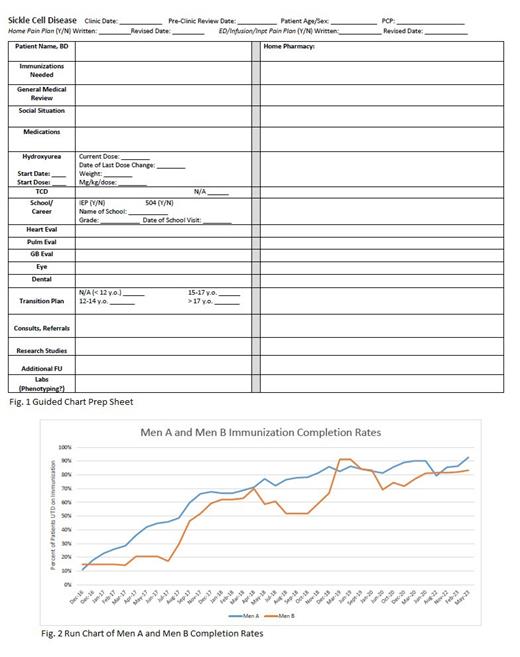Background: Clinics have mostly used pre-clinic chart reviews to increase efficiency of patient appointments and typically only include the provider the day the patient is seen in the clinic. Additionally, these pre-clinic chart reviews tend to focus only on the biomedical needs of the patients and do not often account for the patients' needs relating to social determinants of health (SDoH).
Objective: To improve clinical care consistent with national guidelines and enhance comprehensive care coordination for patients with sickle cell disease (SCD) through an advanced chart preparation process incorporating multi-disciplinary team members (Community Health Worker, Research Coordinators, Nurses, and Medical Providers).
Methods: Scheduled chart-prep meetings (CPMs) are held approximately 2 weeks before SCD clinic, and are routinely attended by the SCD team spanning multiple disciplines: community health worker (CHW), research coordinators (RC), nurses, and providers. If additional personnel, such as palliative care, counseling, exercise physiology, dietitian, etc., are needed for CPMs, they are invited in advance to the meeting. In preparation for the CPM, a nurse care coordinator conducts a chart review of each scheduled patient to complete a standardized guided chart prep sheet (Fig. 1). During CPMs, the chart prep sheet is used to discuss each patient to ensure all standard of care guidelines are met along with quality improvement objectives. The guided sheet also addresses personalized medical needs for the individual patient, social needs, school/career plans, transition, subspecialty referrals, and screening for eligibility to participate in open QI and research projects. The CPMs assure optimal completion of the following pre-appointment activities: (1) order placement, (2) acquiring external patient data relevant to the upcoming visit, (3) coordinating other same-day testing/appointments, and (4) accommodating social needs (i.e., transportation). After closing any care gaps, the CPM sheet is incorporated into the clinic appointment flow for brief provider review immediately prior to seeing the patient and to assure completion of all needed assessments.
Results: CPMs have improved a variety of patient care metrics, making patient appointments more efficient, comprehensive, and patient-focused, and improving pre and post-appointment coordination of care.
The advanced chart preparation process increases efficiency for patients, families, and providers. One example has been the increase of annual TCD completion rates from 50% to 93%, largely accomplished by coordinating TCD and clinic appointments, especially for patients living hours from the clinic. Combining other services and appointments on the same appointment day minimizes transportation needs and maximizes completed referral appointments. Incorporating a patient immunization database into CPMs has improved immunization completion rates significantly, more than doubling the rates for some (Men A from 11% to 93%, Men B from 15% to 83%) (Fig. 2).
Overall, the CPMs: 1) maximize quality time with patients, 2) assure discussion of non-medical (interpersonal, school, etc.) issues, 3) encourage patient and family medical education opportunities, 4) emphasize attention to each patient's individual SDoH needs, 5) increase successful care coordination, 6) enhance collaboration among members of the SCD care team, 7) provide ongoing focus on QI initiatives, and 8) facilitate patient enrollment in open clinical studies and research trials.
Conclusions: Our multidisciplinary SCD care team found that CPMs result in more efficient, effective, and comprehensive patient- and family-centered care while promoting care collaboration by team members. They promoted adherence to guidelines, as evidenced by significant increases in TCD (up 43%) and immunization rates (average improvement 36%, with biggest improvements 82% and 68%, shown above). In addition, the time put into appointment preparation has allowed us to use more clinic time to develop trusting relationships with the patients and families we serve. Furthermore, this process has facilitated patient participation in QI efforts, new databases, and clinical trials. Such chart prep meetings are easily adaptable to a variety of clinical care teams and health delivery settings.
Disclosures
No relevant conflicts of interest to declare.


This feature is available to Subscribers Only
Sign In or Create an Account Close Modal